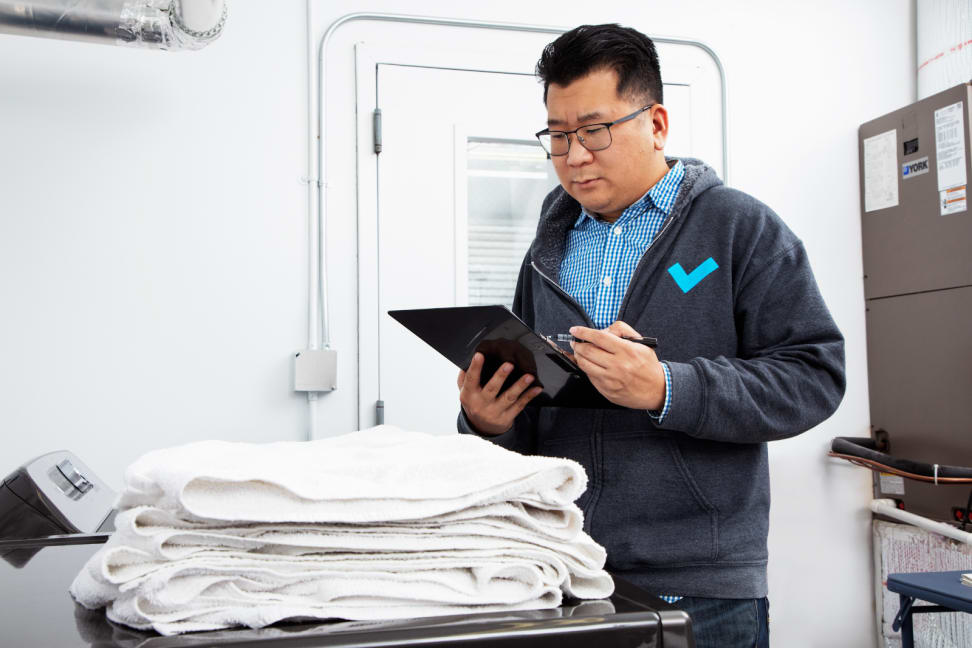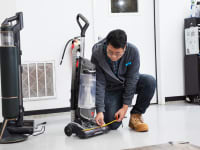 Credit:
Reviewed / Timothy Renzi
Credit:
Reviewed / Timothy Renzi
Recommendations are independently chosen by Reviewed's editors. Purchases made through the links below may earn us and our publishing partners a commission.
The Reviewed lab team has been testing large appliances for over 10 years, from fridges to dishwashers to washers and dryers.
Within the dryer space, we've tested and reviewed models from every popular brand—Maytag, Bosch, LG, Electrolux, Samsung, Miele, GE, Whirlpool, and more—and every conceivable variety, including full-size dryers and compact ventless dryers.
Reviewed’s lab team uses one of its more straightforward testing rubrics for dryers, but this doesn't mean we go easy on them. We put each dryer through the same standardized tests, developed in-house and based on industry standards, thorough research, and years of hands-on experience.
Reviewed's chief scientist David Ellerby, Ph.D., oversees our lab testing and focuses on balancing fast, effective cycles against the wear and tear damage on laundry that can be caused by excessive agitation and heat.
"Consumers have high standards when it comes to dryers," Ellerby points out. "They want their clothes perfectly dried, wrinkle-free, and ready to wear ASAP. This is a tough task for a dryer. Too much heat and your clothes can be damaged; too little and you get damp clothes or endless drying cycles."
The Reviewed lab’s testing focuses heavily on temperature, cycle time and drying performance to find the dryers that hit that elusive target. "There's a sweet spot where the balance between heat and time is ideal,” says Ellerby. And that’s what we are looking for."
Here is a quick overview of how we test dryers in the Reviewed labs.
Our testing facility: The Reviewed Lab
Want to know what makes Reviewed stand apart from competitive product review sites like Wirecutter, Cnet, The Spruce, and Better Homes & Gardens? We go beyond user experience, travel farther than a home improvement store floor. We bring large appliances like dryers into our Cambridge, Mass., testing facility, and we run them through a rigorous testing process based in science and compliant with industry standards. Our own chief scientist and our lab technicians gather data and use it to form assessments, which result in our findings. This process puts us in the ranks of product testing legends, Consumer Reports and Good Housekeeping.
When it comes to dryers specifically, we test in a controlled environment where every dryer is connected to a vent that has two 90-degree angles all the same distance to the outside wall. These conditions create equal backpressure for each dryer. We also base some of our tests on industry standards set by AHAM, following the organization’s guidelines regarding load size and composition.
Standardized loads of laundry yield consistent results

Each load of laundry is standardized to ensure each dryer we test is being put through the same paces.
Each load of laundry is standardized to ensure each dryer we test is being put through the same paces.
Standardization is at the heart of how we test dryers. According to Jonathan Chan, our senior manager of lab operations, "Our dryer testing revolves mainly around finding out three things: how well a dryer removes moisture, how quick cycles are, and whether or not it'll damage your clothes.”
This is why Reviewed’s dryer testing takes place in a lab room with its own dedicated HVAC system, to ensure the ambient conditions are always consistent and ensure our results are accurate. Keeping the environment of the testing lab consistent is important because excess heat or humidity can affect how efficiently the dryers are able to remove water from laundry.
We use the same standardized loads of laundry for each cycle of a given type, with the same amount of water added and evenly distributed throughout.

We use the same standardized loads of laundry for each cycle of a given type, with the same amount of water added and evenly distributed throughout.
We also use the same standardized loads of laundry. For normal and delicates cycles we use an 8-pound load wet to 1.7 times its weight. For quick cycles we use a 4 pound load wet to 1.7 times its weight. For bulky cycles we use a comforter wet to 1.5 times its weight.
By knowing the weight of each load of laundry, as well as how much water we're adding, we're both ensuring each dryer has to do the same amount of work and also making measurements for our first test a lot easier.
We weigh the laundry after a dry cycle to determine how much water has been removed

We weigh the laundry both before starting a cycle and afterwards, letting us capture exactly how much water was removed.
We weigh the laundry both before starting a cycle and afterwards, letting us capture exactly how much water was removed.
The main function of a dryer is to remove water from damp laundry. Fortunately, this is extremely easy to test.
We already weigh the laundry, both dry and wet, before each cycle. Because we also weigh the laundry after each cycle, we can easily determine how much water in total was removed.
We use "dryness per minute" to make judging a machine's efficiency a snap
Because we carefully measure exactly how much water we're adding to each test load of laundry, we can figure out how efficient a dryer is by calculating the rate of how much water it removes over the course of a cycle, or "dryness per minute."
If a dryer has longer cycle times, or if a cycle ends with more damp laundry, it won't be as efficient as a dryer with a higher rate of dryness per minute and use more resources to get your laundry dry.
We monitor wear-and-tear damage using temperature sensors
The main way a dryer can create wear-and-tear is by using excess heat.
Measuring the damage from heat is easily done with a few temperature sensors added to the load of laundry. These tiny button-like devices tumble around with the laundry, taking a reading every couple of minutes. The main number we're looking for here is 150°F: If temperatures exceed 150°F, the fabrics will start to get overly dry and filaments can begin to crack. The longer temperatures are hotter than that threshold, the worse the damage will be.
We also use the dryers just like you would

We use each dryer to make sure there aren't any significant pain points in the overall user experience.
We use each dryer to make sure there aren't any significant pain points in the overall user experience.
User experience is an important part of testing a product. A dryer could have incredible drying power, use barely any electricity, have blazing fast cycle times, and still feel like a chore to use.
As such, we make sure to use each dryer exactly as the average consumer would use them. We load and unload laundry, we customize the drying cycles, and we make sure each component is intuitive and easy to use.
This involves extra steps for smart appliances, as we need to dive into their apps to check out how easy they are to use and what additional functionality they provide. We're mainly looking for what kind of user experience the app provides, as most smart suites offer remote control and notifications as their most useful features.
At the end of the day, whether your clothes are 1% dryer or not probably won't be at the forefront of your mind—the user experience, on the other hand, will probably stick with you.


